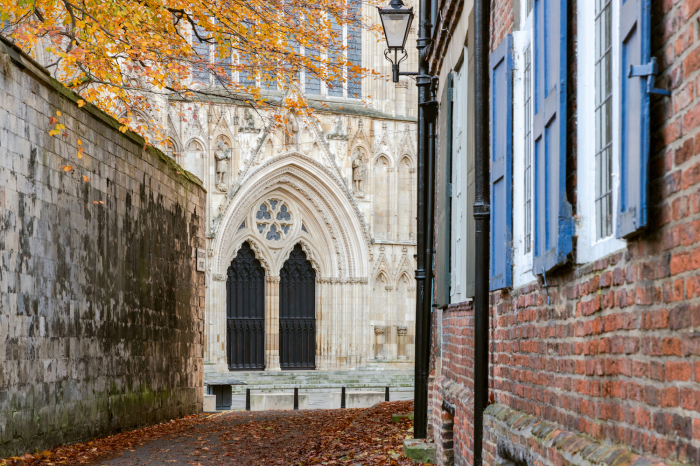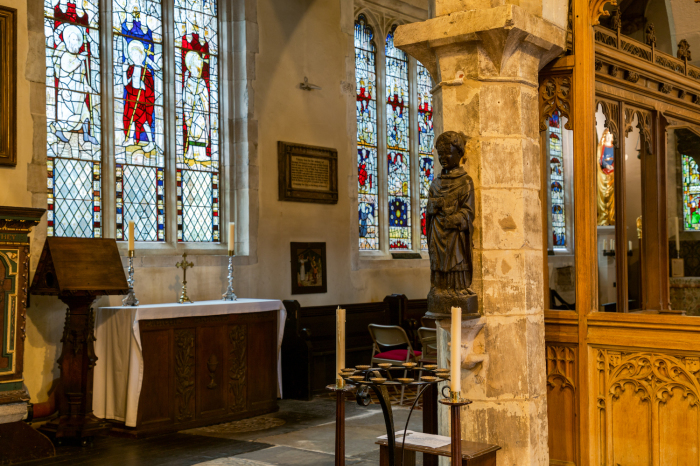Postcard from York, where Constantine the Great was proclaimed emperor

There are few places more significant in the development of the church than York, England.
That’s because it was here in 306 — as in 1,716 years ago — that Constantine was proclaimed emperor. Back then, York was called Eboracum by the Romans.
Constantine, better known as Constantine the Great, was the Roman emperor who proclaimed Christianity the imperial religion. Hence the sculpture of him outside the south transept of York Minster, as the Cathedral and Metropolitical Church of St. Peter in York is more usually called.

The minster is a cathedral because it contains the cathedra or chair of the archbishop of York, the second-highest prelate in the hierarchy of the English church since long before the Reformation. The archbishop, who also holds the rather grandiose title of primate of England, is an indirect successor to the first bishops of York, who were present at the early ecumenical councils.
Within the Gothic minster, the octagonal Chapter House, where the chapter or council that administers the cathedral historically met, is spectacular. Meanwhile, the undercroft was transformed a few years ago into an interactive museum. Visitors can also climb the 275 steps to the top of the central tower, which offers incredible cityscape views.
While the iconic minster is York’s major draw, the city has several other historic churches that are worth visiting.

The most notable is probably Holy Trinity Church, Goodramgate.
Under the care of the Churches Conservation Trust, a charity that preserves old churches without active congregations, it’s a superb example of how medieval churches would have looked in the years after the Reformation thanks to the period box pews. Unfortunately, visiting hours are limited.
In the shadows of the minster is the Church of St. Michael-le-Belfrey, which has been raising funds for a modernization that would radically alter the interior and Victorian-era west front.
The church’s claim to fame is hosting the baptism of Guy Fawkes in 1570. Fawkes, who later converted to Roman Catholicism, led the infamous 1605 Gunpower Plot against King James I — the namesake of the King James Bible — that is still remembered every Nov. 5 with bonfires and fireworks.

Perhaps the most interesting of York’s historic churches is the Church of All Saints, North Street.
While part of the Church of England, All Saints is wholly within the Catholic tradition of Anglicanism. The real draw here is the ornate interior, which manages to feel more Catholic than many Roman Catholic churches. Besides some of the oldest stained-glass in England and carved angels from the 15th century in the roof above the chancel, there’s a rare pre-Reformation carved wooden statue depicting St. William of York. William, a twice-archbishop, reportedly died of a poisoned chalice in 1154.
Also worth visiting are the ruins of St. Mary’s Abbey, which was one of the richest and most powerful English Benedictine monasteries, and St. Denys’s Church with its somewhat uncommon dedication to a martyred bishop of Paris and patron saint of France.
Hidden away in plain sight on the Shambles, a postcard-perfect medieval street popular with tourists, is the overlooked Roman Catholic Shrine of St. Margaret Clitherow. A small chapel is located within a period home that was the house of Clitherow, a butcher’s wife who was martyred in 1586 for refusing to convert to Protestantism.
If you go
I stayed at the Dean Court Hotel. The quaint hotel has the best location of any hotel in the city. Many of the well-appointed and recently renovated rooms face York Minster and the Church of St. Michael-le-Belfrey.
Getting here from London is easy and takes about two hours by train. I took London North Eastern Railway’s nonstop service between King’s Cross and York. A first-class ticket is worth the added cost, although the departure lounges at both stations were pathetic and really nothing more than an overcrowded waiting room.
Trip planning resources are available through Visit York.
Dennis Lennox writes a travel column for The Christian Post.
Dennis Lennox writes about travel, politics and religious affairs. He has been published in the Financial Times, Independent, The Detroit News, Toronto Sun and other publications. Follow @dennislennox on Twitter.





























